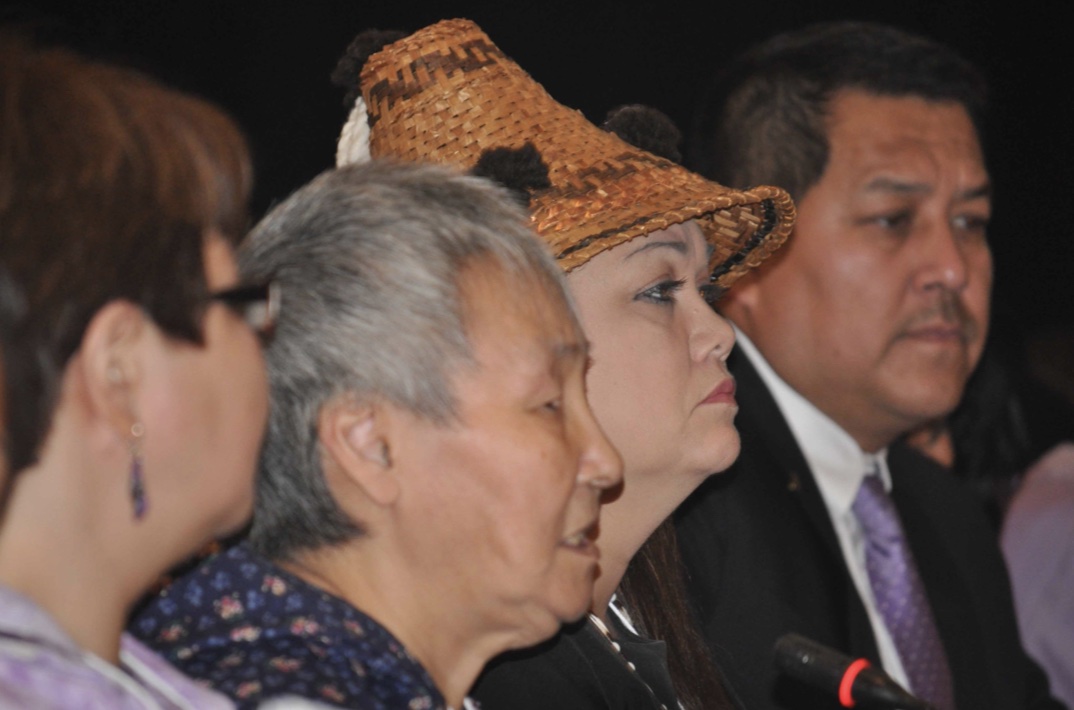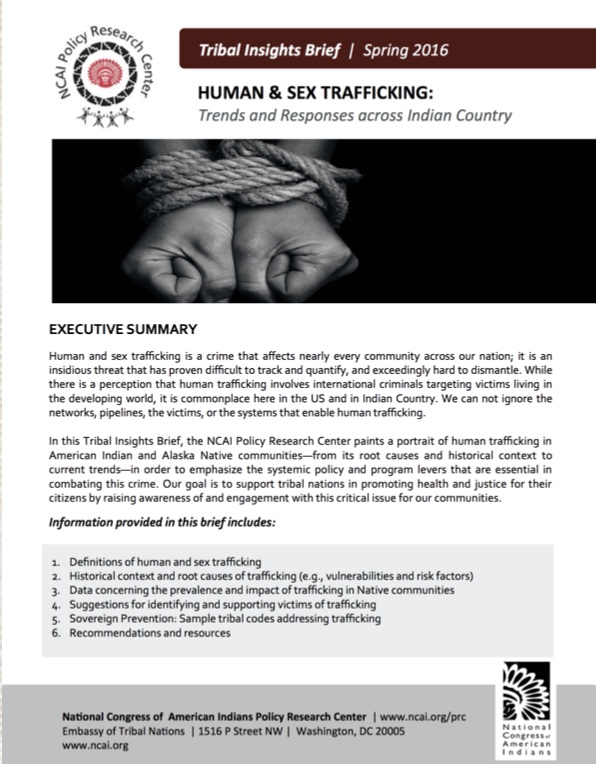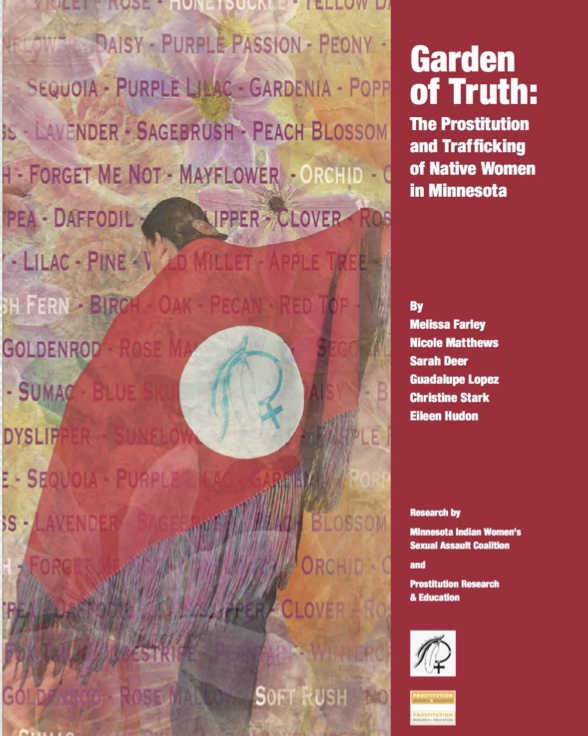New GAO Reports on Human Trafficking to Congress: A Tribal Perspective
 Trafficking, in multiple forms, has been utilized as a tool of genocide and colonization of American Indians and Alaska Natives within the United States since contact. The intentional use of force, in both sexual and labor contexts, against American Indians and Alaska Natives is an act that seeks to degrade tribal sovereignty through an actual stealing away of our people or a utilization of them in unnatural ways. Recently, there has been an uptick in interest from Congress regarding human trafficking in tribal communities, and as such, this article will serve as an overview and update.
Trafficking, in multiple forms, has been utilized as a tool of genocide and colonization of American Indians and Alaska Natives within the United States since contact. The intentional use of force, in both sexual and labor contexts, against American Indians and Alaska Natives is an act that seeks to degrade tribal sovereignty through an actual stealing away of our people or a utilization of them in unnatural ways. Recently, there has been an uptick in interest from Congress regarding human trafficking in tribal communities, and as such, this article will serve as an overview and update.
Forms of Human Trafficking Recognized Under Federal Law
There are two forms of human trafficking that are generally recognized in federal law—sex trafficking and labor trafficking. The Trafficking Victims Protection Act of 2000 (TVPA) defines human trafficking as “severe forms of trafficking in persons.” Essentially, this means that trafficking under the TVPA is 1) sex trafficking involving the recruitment, harboring, transportation, provision, obtaining, patronizing, or soliciting of a person for a commercial sex act through force, fraud, or coercion, or where the victim has not yet attained 18 years of age; or 2) labor trafficking involving the recruitment, harboring, transportation, provision, or obtaining of a person for labor or services, through the use of force, fraud, or coercion for the purposes of subjection to involuntary servitude, peonage, debt bondage, or slavery. Various tribes and states also have separate definitions of human trafficking (many of which resemble the federal definitions found in the TVPA).
In 2015, President Obama signed the Justice for Victims of Trafficking Act into law. This act required the United States Attorney General to ensure that law enforcement and federal prosecutors received anti-trafficking training; required the Federal Judicial Center, the research and education agency of the federal judicial system, to provide training for judges on ordering restitution for victims of certain trafficking-related crimes; mandated that the Secretary of Homeland Security implement a human trafficking training program for department personnel; required the Attorney General to implement and maintain a national strategy for combating human trafficking; established the Domestic Trafficking Victims’ Fund to supplement the existing statutorily authorized grants or activities; and amended the federal definition of child abuse to include human trafficking.
 “My daughter was and still is a victim of sex trafficked women. I reported it to the authorities and received no help. I told them the address, location, and names of her traffickers. The Anchorage Police Department would not listen to me until I got my two white friends to make a call for me. I contacted Priceless Alaska but they would not help me unless a State Trooper investigates and makes a referral to their organization. No one would help me. I also called the FBI, three times, and they did not respond. Through, my 2 white friends, I reported her missing. My daughter was held, by traffickers, at Eagle River, Alaska, for 4 months.”
“My daughter was and still is a victim of sex trafficked women. I reported it to the authorities and received no help. I told them the address, location, and names of her traffickers. The Anchorage Police Department would not listen to me until I got my two white friends to make a call for me. I contacted Priceless Alaska but they would not help me unless a State Trooper investigates and makes a referral to their organization. No one would help me. I also called the FBI, three times, and they did not respond. Through, my 2 white friends, I reported her missing. My daughter was held, by traffickers, at Eagle River, Alaska, for 4 months.”
—Martina Post,
Testimony of the Native Village of Alakanuk, USDOJ Tribal Consultation, December 6, 2016
Trafficking and Native Women
Victimization in the human trafficking context centers on one concept: vulnerability. American Indians and Alaska Natives’ vulnerabilities are compounded and come in many forms: poverty, geographic remoteness, homelessness, prior abuse, and the broken system of foster care. Perhaps the largest vulnerability is invisibility. This extreme form of marginalization
exists due to the root causes of violence in tribal communities: colonization and genocide. While often attributed in a historic context colonization and genocide is reflected in the current, on-going, continuing relationship of the United States to Indian nations and is the underlying foundation allowing trafficking as a crime pattern to remain unaddressed. Current federal law as expressed in Congressional acts, Supreme Court cases and Executive Orders limit the authority of Indian nations to fully protect women and respond to crimes of trafficking. Native women as a population often are viewed as “unprotected prey” for hunters, oil rig workers, federal workers and so many other grouping of predators. The reality of unprotected and invisibility go hand in glove.
But perhaps this reality also lends insight as to why human trafficking is so severely underreported in tribal communities. Why report if nothing will be done?
Of course, the general distrust that American Indians and Alaska Natives have toward law enforcement compounds the difficulty of protecting Native women and children from traffickers. Even if a victim should choose to engage with law enforcement, there is currently no data collection or method of collection that provides a clear picture of the statistical prevalence of human trafficking and response of the criminal justice system to victims in our communities. All of this, in part, explains why data on human trafficking in tribal communities is sparse, if even existent.
Government Accountability Office Reports to Congress
Because of recent Congressional interest in this issue as specific to American Indian and Alaska Native victims, the United States Government Accountability Office (GAO) has been analyzing what data does exist. So far this year (2017), the GAO has released two publicly facing reports to Congressional Requesters. The first report, titled Human Trafficking: Action Needed to Identify the Number of Native American Victims
Receiving Federally-funded Services, was released in March. A copy of the report can be found at https://www.gao.gov/assets/690/683805.pdf
Yet, the GAO found that for the years of 2013–2016, there were only 14 federal investigations, and 2 federal prosecutions of human trafficking offenses in Indian Country.
The report specifically addressed two questions:
- To what extent do federal agencies collect and maintain data on investigations and prosecutions of human trafficking in Indian Country or of Native Americans regardless of location?
- To what extent are federal grant programs available to help address human trafficking in Indian Country or of Native Americans regardless of location, and how many Native American trafficking victims have received assistance through these programs?
In regards to the first inquiry, the GAO primarily analyzed data from federal investigative and prosecutorial bodies with the Department of Homeland Security (DHS), the Department of the Interior (DOI), and the Department of Justice (DOJ) from fiscal years 2013–2016. The GAO looked at the number of human trafficking investigations and subsequent prosecutions each agency conducted for which the crime occurred in Indian Country or at least one of the victims was identified as American Indian or Alaska Native.
As most in the movement are aware, within the DOJ, the Office of Violence Against Women (OVW) and the Office of Justice Programs (including Office of Juvenile Justice and Delinquency Prevention, the Office for Victims of Crime, the Bureau of Justice Assistance, and the National Institute of Justice) provide federal grants to help state, local, and tribal enforcement agencies as well as non-governmental agencies (NGOs) who assist trafficking victims or who conduct research regarding the same. HHS also provides grant funding to entities to provide services and support for victims through the Administration for Children and Families (which includes the office on Trafficking in Persons, the Children’s Bureau, the Family and Youth Services Bureau, and the Administration for Native Americans).
The report made two important findings:
- Most of the federal investigative and prosecutorial agencies that address human trafficking do not consistently collect Native American status of victims in their cases; and
- At least 50 federal grant programs can be used to address human trafficking in Indian Country or of Native Americans, but the number of Native American victims served is unknown.
As to the first finding, the GAO reported that three of the four investigative and prosecutorial agencies maintain data on human trafficking cases in Indian Country. The FBI, the BIA, and the USAO record whether the crime took place in Indian Country. Yet, the GAO found that for the years of 2013–2016, there were only 14 federal investigations, and 2 federal prosecutions of human trafficking offenses in Indian Country. The GAO also reported that most (three out of four) of the federal investigative and prosecutorial agencies that address human trafficking do not consistently collect the Native American status of the victims in their cases. Thus, according to this same report, the total number of federal human trafficking investigations and prosecutions that involved Native American victims is unknown.
During their survey of investigative and prosecutorial bodies, the GAO heard two concerns about collecting victim Native American status information: relevance; and, victim privacy
The first point, that a victim’s status as a Native American is not relevant, is clearly undercut because knowing that information is necessary for establishing which law enforcement agency has jurisdiction (this point is well reflected in the GAO report itself). The second point, however, that a victim’s privacy may very well be jeopardized by the release of information pertaining to Native American status resonates strongly with many advocates in the movement. This is especially true in smaller tribal communities, or in non-tribal communities where the prevalence of Native Americans may be statistically low enough to identify a victim simply by knowing their status as an American Indian or Alaska Native.
In regards to the second finding, about the availability of federal grant programs that may address human trafficking in Indian Country or of Native Americans, at least 50 grant programs from fiscal years 2014–2016 were identified by the GAO that could help address human trafficking in tribal communities. Of the 50 grant programs the GAO identified, 45 of them specifically mention addressing human trafficking as an allowable use of funding (the other 5 mention assisting Native American crime victims as an allowable use, though they do not explicitly mention human trafficking). The report states that of the 45 grant programs that mention human trafficking as an allowable issue to devote resources to, only 2 address human trafficking in tribal communities exclusively. The report stated that the total number of Native American victims of trafficking who receive services under the identified programs is currently unknown.
“The report states that of the 45 grant programs that mention human trafficking as an allowable issue to devote resources to, only 2 address human trafficking in tribal communities exclusively.”
Among the 21 grant programs administered by HHS and the DOJ, the number of human trafficking victims who are served is unknown because the agencies do not strictly require grantees to report on the Native American status of those they serve. Even when grantees are required to provide the Native American status of the victims they serve, they are only required to do so in the aggregate. This means the type of crime is not specified. Thus, according to the GAO, the grantee data cannot be used to determine the number of Native human trafficking victims.
The GAO report stated with regards to OVC and OJJDP, grantees are not required to collect and report Native American status of victims because it is, for the most part, not dispositive to eligibility. Both OVC and OJJDP raised concerns about victim confidentiality.
The report made two recommendations for executive action:
- The Director of OVW require grantees to report the number of human trafficking victims served using grant funding and, as appropriate, the Native American status of those victims; and
- The Assistant Attorney General for OJP direct OVC and OJJDP to require their grantees to report the number of human trafficking victims served using grant funding, and as appropriate, the Native American status of those victims.
Neither of these recommendations account for the valid concerns raised about victim confidentiality. But another important distinction to make clear is that these grant programs identified can address human trafficking, just as they can any combination (singular or plural) of the other purpose areas under their funding. This could be easily perceived as an unfunded mandate to address human trafficking in addition (and) to other purpose areas grant programs addressed. This is problematic as an unfunded mandate in and of itself, but also because addressing human trafficking as a direct service provider is distinct from addressing the other purpose areas; for example, intimate partner violence. Our grant programs in tribal communities are already without personnel, training, and capacity to fully address the severe rates of violence in our communities, without also having to add another distinct layer to that work.
It is important to note that in 2013 the movement rallied, as indicated by a resolution passed by NCAI to amend the VAWA tribal title to allow Indian tribes to use grant funds to specifically address sex trafficking. Prior to this amendment tribal grantees could not use VAWA funds to design and provide services to specifically to victims of sex trafficking. At this time
no other grant program under VAWA includes sex trafficking of tribal victims as a purpose area. Thus, under the VAWA, only Indian tribes, who are under- resourced and under-staffed, and lack criminal jurisdiction over non-Indian traffickers can specifically serve victims of sex trafficking with funding under VAWA.
The second report, titled Human Trafficking: Information on Cases in Indian Country or that Involved Native Americans, was released in July. A copy of the report can be found at https://www.gao.gov/assets/690/686051.pdf
The report addressed three issues:
- The extent to which tribal and major city law enforcement agencies have encountered human trafficking in Indian Country or of Native Americans;
- Factors affecting the ability of law enforcement agencies to identify and investigate this specific human trafficking; and
- The availability of services to Native American victims of human trafficking based on the perspectives of law enforcement agencies and victim service providers.
The GAO conducted surveys of all tribal law enforcement agencies that were identified by the Bureau of Indian Affairs, which numbered 203. It also surveyed 86 major city law enforcement agencies, and 315 victim service provider organizations that received fiscal year 2015 Department of Justice or Department of Health and Human Services grants that could be used to assist human trafficking victims. This report summarized a survey of tribal law enforcement agencies which were asked to identify the number of investigations that they considered to have involved human trafficking from 2014–2016: 132 tribal law enforcement agencies responded and 27 of them reported that between 2014–2016 they initiated human trafficking investigations. Of those 27, 24 provided the number of investigations they conducted, which amounted to 70 total cases (58 victims).
While, the GAO asked tribal law enforcement agencies about the number of human trafficking investigations they conducted in Indian Country, the GAO asked major city law enforcement agencies about the number of human trafficking investigations that involved at least one Native American victim. Only 6 of the major city law enforcement agencies reported they investigated human trafficking cases with at least one Native American victim. Of the 6 reporting, they reported a total of 60 investigations involving 81 Native American victims from 2014–2016. For each of these investigations, the number of Native American victims ranged from 0–31. Of the 6 that reported, Minneapolis PD reported the majority of the 60 investigations.
This second report stated that some tribal law enforcement agencies believe that human trafficking is occurring at a higher rate than is being reported. This backs up what the movement knows generally about human trafficking victimization. It also stated that law enforcement agencies cited “victim reluctance” to participate in investigations as a special barrier to serving Native American victims in the context of human trafficking. This observation supports the lack of trust that tribal victims have in regards to law enforcement. Other barriers were also identified by law enforcement as reasons that victims do not engage in with law enforcement or participate in investigations relating to human trafficking. The following were barriers identified by tribal law enforcement: fear of retaliation from trafficker, traumatization, the victim does not ascribe to victimization, the victim distrusts law enforcement, the victim is attached to the trafficker in a sentimental way, the victim is underage, and the victim suffers from a chemical dependency. The following were barriers identified by major city law enforcement agencies: fear of retaliation, traumatization, or the victim may be discouraged by family from cooperating.
Not surprisingly, when tribal law enforcement was asked to identify factors other than the victim’s reluctance to participate in the investigation, the following themes emerged:
- Lack of resources, such as necessary training, equipment and funding for sex crime investigations;
- Inter-agency cooperation is absent or deficient; and
- A lack of appropriate laws in place.
These themes are generally recognized in the movement as long-standing barriers to those most serving victims of gender-based crime in Native American communities broadly. The respondents in this second report, again comprised mostly of law enforcement agencies, reported an array of services variable to Native American human trafficking victims. However, they also reported that victims’ feelings of shame and lack of resources were barriers to obtaining these services. From the advocate standpoint, these reported sentiments seem to conflict. To state that there is an array of services available but that a general lack of resources serves as a barrier to obtaining them seems an oxymoron. Service providers and tribal and major city law enforcement officers reported that shelter, substance abuse treatment, health and other services are all available to Native American victims of trafficking. However, a footnote to the report states that the GAO compiled the list of potential services for human trafficking victims, based on interviews with potential survey respondents and the GAO’s review of “related research on human trafficking of Native American victims.” It is unclear how the latter affected the overall results, or how the self-reporting on the part of potential survey respondents affected same. The report later clarifies that “the barrier to providing services to human trafficking victims that service providers identified most frequently was inadequate funding or resources.” (See page 23 GAO-17-624 Native American Human Trafficking). In addition, tribal service providers cited a lack of staff, emergency shelter, and legal resources to meet the needs of victims in their communities. Service providers identified two areas in which the federal government could support their endeavors to service Native American victims of human trafficking:
This second report made no recommendations. However, it did cite to a National Congress of American Indians brief on “Trafficking in Indian Country,” which stated that many Native human trafficking victims felt they owed their survival to Native cultural practices. These same victims expressed a desire for access to traditional healing. HHS’s Administration for Native Americans similarly reported that there was a need for culturally relevant and trauma-informed approaches when assisting victims in Indian Country.
On July 27, 2017, U.S. Senator Tom Udall, vice chairman of the Senate Committee on Indian affairs, held a stakeholder meeting on ways to more effectively address human trafficking in Indian Country. Following this meeting, he released the following statement:
“Human trafficking affects every community in the United States—regardless of age, gender, ethnicity and socioeconomic background. And because Native Americans disproportionally face high rates of poverty and trauma, they are especially vulnerable and frequent targets of human trafficking. For years, Tribal leaders and Native activists have raised the issue of human trafficking with Congress. By sharing their powerful and often heart-breaking stories, they have elevated our awareness about the need for more information and more resources to combat the spread of human trafficking in Indian Country.
“But the fact is that the federal government knows very little about the rates of human trafficking on Tribal lands. And it knows even less about human trafficking of individual Native Americans. After reviewing these GAO reports, it is clear that the true extent of human trafficking in Indian Country remains unknown. But it is also clear to me that the federal government could do more to help Native victims who are slipping through the cracks. Congress must take a long, hard look at how federal agencies collect and monitor data on this issue, ensure their accountability, and then work to provide federal and Tribal law enforcement agencies with enough resources to keep Indian Country safe. The administration’s proposed cuts to federal law enforcement agencies and Tribal programs would only further strain public safety initiatives on Tribal lands. Instead of jeopardizing Native communities by cutting policing and justice budgets, Congress should look for new ways to get funding resources to Tribes.
“Like with other crimes in Indian Country, addressing human trafficking will require Congress to look at and pass legislation that addresses issues of jurisdiction and inter-agency cooperation, and I’m hopeful that we can work together to provide Tribes with more resources to combat human trafficking and ensure that all Native victims of crime get the support
they so desperately need.” (Source: https://nativenewsonline.net/currents/sen-udall-holds-listening-session-human-trafficking-indian-co…).
The Minnesota Indian Women’s Sexual Assault Coalition, the National Indigenous Women’s Resource Center, the National Congress of American Indians, and other allies have been actively engaging with Members of Congress (specifically Senators Udall, Cortez-Masto, and Tester) through conference calls and Hill visits regarding their interest and request for information on this critical issue.
The Essential Role of the Tribal Grassroots Movement
Congressional interest in the human trafficking of Native women appears to be of increased concern as reflected by legislation to enhance the federal response introduced this year. Similar to other Congressional actions to address violence against Native women this interest is linked to the grassroots movement across American Indian tribes and Alaska Native villages. At past VAWA annual consultations, tribal leaders have consistently raised the concern of sex trafficking and recommended: increased federal-tribal coordinated efforts to address trafficking, increased resources to Indian tribes to enhance their response and services to trafficking victims, and perhaps most important amending federal law to allow Indian tribes to respond to non-Indian traffickers at the tribal level.
These concerns and recommendations are well demonstrated by the testimony of tribal leaders at past annual consultations and the NCAI resolution supporting the tribal VAWA 2013 amendment allowing tribes to use their VAWA funds to address this issue. Unless Indian nations have the authority and resources to fully respond to trafficking of Native women the unprotected status and barriers to the safety of Native women will allow human traffickers to continue to prey upon those most vulnerable.
 Tribal Resources Addressing Human Trafficking
Tribal Resources Addressing Human Trafficking
Human & Sex Trafficking: Trends and Responses across Indian Country,” Tribal Insight Brief, NCAI Policy Research Center, 2016. https://goo.gl/TVB8KK
Responsible Resource Development and Prevention of Sex Trafficking: Safeguarding Native Women and Children on the Fort Berthold Reservation,” American Indian Law Clinic, University of Colorado Law School, 2016. https://goo.gl/3Rq4No
Support for Maintaining Collaborative Efforts with Federal, State, and Private Partners to Combat Human Trafficking in Indian Country, NCAI Resolution #PHX-16-078.  https://goo.gl/5s3SL8
https://goo.gl/5s3SL8
“Garden of Truth: The Prostitution and Trafficking of Native Women in Minnesota,” Minnesota Indian Women’s Sexual Assault Coalition, 2011. https://goo.gl/so6LJq





